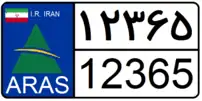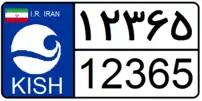Vehicle registration plates of Iran
Iranian license plates have had European standard dimensions since 2005. Each province in Iran has multiple unique, two-digit codes that are included at the right end of the license plates in a distinguished square outline, above which the word ایران or "Iran" has been written. A province's license plates will not be issued with a new code unless all possible combinations with the old code have been issued. In Tehran, the first code to be issued for the province was code 11, and subsequent codes all increased by 11 as well (meaning codes 11,22,33,...,99 are unique to Tehran.) Ever since code 99 was fully issued, the new codes for Tehran have started from 10 and subsequently increased by 10. Most province codes increase by 10 based on the first code issued for their province. Khuzestan Province, for example, has been allocated codes 24 & 14, and code 24 will not be used before code 14 is fully issued.
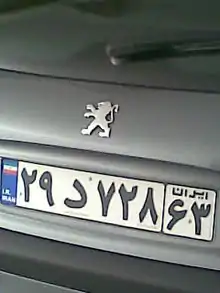
A car from Shiraz

A car from Tehran city
Private cars
The plate is black on white. The code in the square represents the regional codes. The letter ب can be any letter depending on the district within the region covered by the numerical code.
 |
Private cars of people with disabilities
The plate is black on white. To distinguish the type of the plate, there is a wheelchair symbol put on the plate. The code in the square represents the regional codes. The wheelchair symbol in the plate is fixed for all private cars of people with disabilities and these types of plates are issued provincially.

Motorcycles
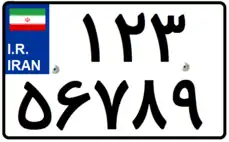 |
Taxis
The plate is black on yellow. To distinguish the type of the plate, there is the letter ت which stands for the word تاکسی, meaning taxi in Persian put on the plate and the English word TAXI above it. The code in the square represents the regional codes. The letter ت with the word "Taxi" on the plate is fixed for all taxis and these types of plates are issued provincially.
 |
Public cars
The plate is black on yellow. To distinguish the type of the plate, there is the letter ع which stands for the word عمومی, meaning public in Persian put on the plate. The code in the square represents the regional codes. The letter ع on the plate is fixed for all public cars and these types of plates are issued provincially.
 |
Agricultural cars
The plate is black on yellow. To distinguish the type of the plate, there is the letter ک which stands for the word کشاورزی, meaning agricultural in Persian put on the plate. The code in the square represents the regional codes. The letter ک on the plate is fixed for all agricultural cars and these types of plates are issued provincially.
 |
Governmental cars
The plate is white on red. To distinguish the type of the plate, there is the word الف (aleph) which is how the first letter of alphabet is pronounced put on the plate .The code in the square represents the regional codes. The word الف on the plate is fixed for all governmental cars and these types of plates are issued provincially.

Protocol vehicles
The plate is white on red and there is the word تشریفات with its English translation under it on the plate. The rest is simply a four-digit number.

Military and law enforcement
Police license plates were introduced first on September 30, 2012. The rest of the plates were introduced on May 30, 2016, with full replacement planned to be done by March 2017.
Police (NAJA) vehicles
The plate is white on dark green. To distinguish the type of the plate, there is the letter پ which stands for the word پلیس, meaning police in Persian put on the plate. The code in the square represents the regional codes. The letter پ on the plate is fixed for all police cars and these types of plates are issued provincially.
 |
IRGC
The following plate is installed on cars belonging to IRGC (Sepah Pasdaran in Persian). The plate is white on dark green. To distinguish the type of the plate, there is the letter ث is used. The code in the square represents the regional codes. The letter ث on the plate is fixed for all IRGC vehicles and these types of plates are issued provincially.
 |
Islamic Republic of Iran Army
The following plate is installed on cars belonging to Islamic Republic of Iran Army. The plate is black on a light shade of brown. To distinguish the type of the plate, there is the letter ش is used. The code in the square represents the regional codes. The letter ش on the plate is fixed for all army vehicles and these types of plates are issued provincially.
 |
Ministry of Defence
The following plate is installed on cars belonging to Ministry of Defence and Armed Forces Logistics. The plate is white on light blue. The letter ز is reserved for this type of plate. The code in the square represents the regional codes. The letter ز on the plate is fixed for all cars belonging to the ministry and these types of plates are issued provincially.
 |
General Staff of Armed Forces
The following plate is installed on cars belonging to General Staff of Armed Forces of the Islamic Republic of Iran. The plate is white on light blue. To distinguish the type of the plate, there is the letter ف is used. The code in the square represents the regional codes. The letter ف on the plate is fixed for all cars belonging to the general staff and these types of plates are issued provincially.
 |
Historic Vehicles
This type of plate is used for older and historically significant vehicles like ones on display at museums. The plate is white on brown with the word تاریخی, meaning historical written above a five-digit number. On the left, there is an Iranian flag and a picture of Bagh-e Melli in Tehran. The dimensions of the plate are American-Standard.
 |
Political and services plates
The new format for political and service plates was introduced on March 6, 2016. Each country or international organization is assigned a 3 digit number (like the ۳۶۵ (365) shown in both examples below). For example, 214 is reserved for Germany. So far, 133 countries have been numbered. For each country's embassy, the first two digits increase (11D, 12D or 11S, 12S).[1]
Political (e.g., Diplomatic/Consular Corps)
 |
Service (e.g., UNHCR)
 |
Previous Format
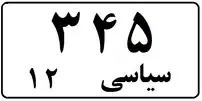 |
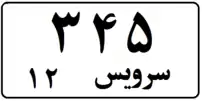 |
Temporary Passage
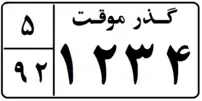 |
Area codes
Area codes in Iran depend on the province the car is registered in.
| Province | Code | Province | Code |
|---|---|---|---|
| Tehran City | 10-11-20-22-33-44 55-66-77-88-99 |
East Azerbaijan | 15-25-35 |
| Tehran Alborz |
21-38-68-78-30 | West Azerbaijan | 17-27-37 |
| Kermanshah | 19-29 | Kurdistan | 51-61 |
| Zanjan | 87-97 | Hamadan | 18-28 |
| Qazvin | 79-89 | Markazi | 47-57 |
| Lorestan | 31-41 | Ilam | 98 |
| Chahar Mahaal and Bakhtiari | 71-81 | Hormozgan | 84-94 |
| Khuzestan | 14-24-34 | Kohgiluye and Boyer-Ahmad | 49 |
| Gilan | 46-56-76 | Qom | 16 |
| Isfahan | 13-23-43-53-67 | Yazd | 54-64 |
| Fars | 63-73-83-93 | Semnan | 86-96 |
| Razavi Khorasan | 12-32-42-36-74 | Sistan and Baluchestan | 85-95 |
| Bojnord | 26 | Birjand | 52 |
| Mazandaran | 62-72-82-92 | Kerman | 45-65-75 |
| Bushehr | 48-58 | Gorgan | 59-69 |
| Ardabil | 91 | Unassigned | 39-40-50-60-70-80-90 |
Letters
The order of letter the plates are issued in follows the alphabetical order of the Persian alphabet, and excludes letters reserved for special license plates. The order is as follows:
- ب
- ج
- د
- س
- ص
- ط
- ق
- ل
- م
- ن
- و
- هـ
- ی
Free Trade Zones
The plate is black on white and consists of a five-digit number written once in eastern Arabic-Indic digits on the top and in Latin digits on the bottom. On the left, there is an Iranian flag and the logo of the respective Free Trade Zone with its name written in English below it. The size of the plate is American Standard. Below are a few examples of these plates.

